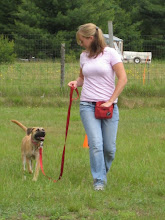My dog must have been abused.
If you are a dog professional or even a dog owner or lover, I'm sure you have heard this numerous times. And while it is possible, it is far less likely than most people think. The fact is that when someone has a dog who flinches, barks, growls, runs away from, or otherwise acts fearful towards men, kids, women, hands, feet, canes, sticks, the crate, etc - the assumption is that whatever the dog is afraid of must have been used abusively toward the dog in his or her past.
If every dog that was thought to have been abused was actually abused, then the majority of people who have ever had a dog must have abused him. My dog Fletcher must have been abused by the wind, gates, men, yelling children, frisbees, and pretty much any and every other household object. When I adopted Fletcher, he was afraid of every noise, quick movement, new man or child, some women, and much more. I could go on and on about the possibilities, but the fact is that the majority of dogs who have fears of specific objects, movements, people - well, there is a much better chance that they probably just weren't socialized to them as a young pup.
Fletcher came up as a stray from North Carolina, and we all know how many hurricanes and high winds they get there. So my guess is that something traumatic may have fallen over in the wind and caused him to have such an intense fear of wind. Beyond that, being a stray, he very likely had little to no experience with household objects or different types of people.
Now, my most recently adopted puppy, Cora - she was never abused, this I know. Yet, she is still reactive to people that try to directly approach her or if she is feeling under social pressure. People who reach out too quickly, people who appear from around a corner, or people who are not as soft as she is comfortable with.
So, when your dog is acting hand shy, foot shy, people shy, flag-in-the-wind shy, take a minute and consider that they were never properly introduced to or socialized with that scary thing. Create positive associations with the object or person. Don't pressure your dog to interact, let them do so on their own. Use toys, treats, and other fun things when the object/person is present and help your dog through his or her fear!
And of course, always contact a professional for assistance!
Wednesday, May 4, 2011
Subscribe to:
Post Comments (Atom)







No comments:
Post a Comment